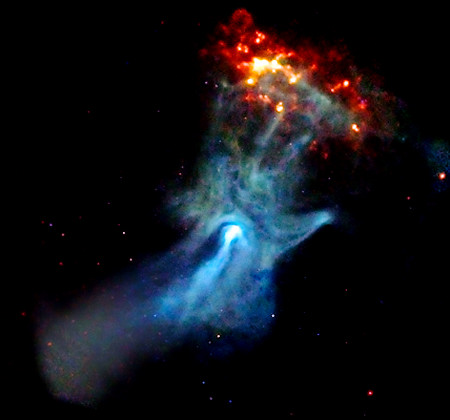NASA's newest telescopic image resembles a giant hand in space that is now being titled as the "Hand of God," which is bringing countless of interpretations and possible definitions from scientists and spectators.

The image was captured by NASA's Nuclear Spectroscopic Telescope Array (also known as NuSTAR), which was created in June 2012 to observe any dead and exploded stars found in outer space. The photograph captured displays the image of an exploded star in a supernova from 17,000 light-years away, which is shaped like an open hand.
In a press release, NASA's Jet Propulsion Laboratory explained the scientific terminology that ultimately led to a giant hand being drawn in the midst of an explosion. "The pulsar is spinning around nearly seven times every second, spewing particles into material that was upheaved during the star's violent death," read the press release. "These particles are interacting with magnetic fields around the ejected material, causing it to glow with X-rays. The result is a cloud that, in previous images, looked like an open hand."
Upon looking at the image, there is a resemblance of an open palm and fingers that are reaching out towards the red cloud that is marked as the explosion. Scientists and investigators at NuSTAR are studying the image precisely to determine the exact shape of the nebula, or space dust as result of the explosion.
The "Hand of God" image has brought the topic of religion into the world of science, which many scientist and astrologists tend to avoid to explain a more scientific approach to the evidence of life and the universe. Despite the astronomical perspective of studying the explosion of supernova star, the "Hand of God" title acknowledges that science may be more open with the notion of a Creator and the universe created.
Former CalTech professor and scientist Arthur Robinson agrees with the title that clearly distinguishes the evidence of a Creator and the creation. "Scientists during most of history have recognized that the vast natural beauty they are privileged to see and study could only have been the product of an awesome Creator," said Robinson.
This is not the first time activity in the Milky Way has brought forth remarkably familiar images. In the past, NASA has captured images that have resembled mountains, butterflies, swirls and even a sombrero. However, the "Hand of God" may bring the most responses from astrologers and scientists, who according to Robinson, "still recognize the hand of God in the natural world."
The image is still being debated whether the hand is merely an optical illusion or a direct result from the explosion. Despite the proposed explanations, the image is still being recognized as the "Hand of God" universally and since its release has brought the topic of God into science, even if its momentarily.














